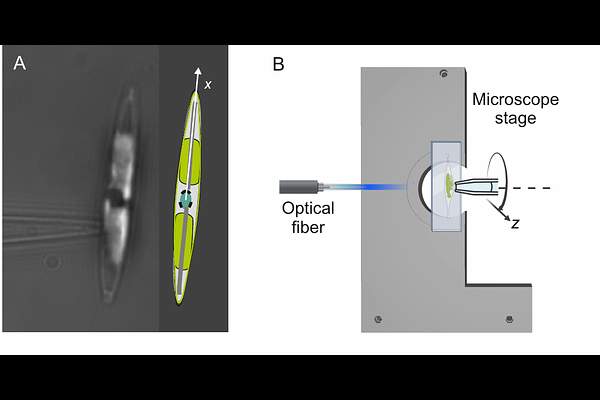Anisotropic fluorescence emission by diatoms modifies the underwater oceanic light field

Anisotropic fluorescence emission by diatoms modifies the underwater oceanic light field
Font-Munoz, J. S.; Arrieta, J.; Marc, S.; Tuval, I.; Basterretxea, G.
AbstractFluorescence in phytoplankton and other autotrophic organisms originates within the cell chloroplasts, where a fraction of the absorbed solar radiation is reemitted at longer wavelengths by photopigments. While traditionally employed as an indicator of physiological status, emerging evidence suggests that natural chlorophyll fluorescence (ChlF) may also play unanticipated functional roles in the marine environment. Here, we examine the ChlF emission fields generated by pennate planktonic diatoms, a key phytoplankton group playing a critical role in global biogeochemical cycles. Using cell micromanipulation experiments, we demonstrate that the ChlF emitted by Pseudo-nitzschia fraudulenta (Bacillariophyceae) is markedly anisotropic, a feature attributed to both the cells\' elongated morphology and the arrangement of chloroplasts within the cytoplasm. In these diatoms, fluorescence is preferentially emitted in the transapical direction, accounting for up to 35% of total emission. However, peak ChlF intensities occur at the cell apices, suggesting that the silica frustule focuses fluorescent light emission along the longitudinal axis. At elevated cell densities (~106 cells/L), the underwater light field is modulated by the combined effects of ChlF emission anisotropy and the preferential alignment of diatom cells within the water column. Numerical simulations indicate that ChlF intensity can vary by up to 15% depending on whether cells are predominantly aligned (commonly in stratified water columns) or randomly oriented. These results suggest that diatom-driven modulation of the light field through structured ChlF emission may influence microscale optical environments, with potential consequences for processes ranging from intercellular signaling to large-scale phytoplankton dynamics, including remote sensing based assessments of phytoplankton physiology.